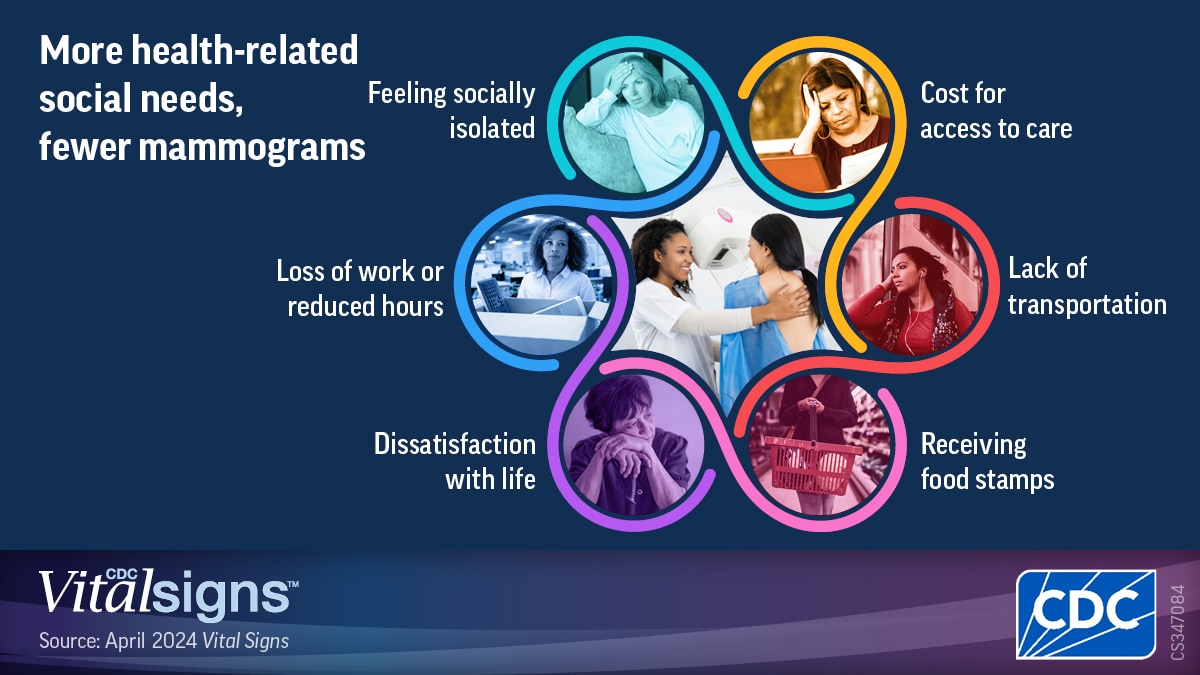Cost and Access Are Not the Only Barriers Women Face in Getting Lifesaving Mammograms
The more health-related social needs a woman faces, the less likely she is to get a mammogram
Embargoed Until: Tuesday, April 9, 2024, 1:00 PM EDT
Contact: Media Relations
(404) 639-3286
A new CDC Vital Signs study finds that only about 65% of women ages 50-74, with three or more health-related social needs, are up to date with their mammograms.
Breast cancer causes more than 40,000 deaths in women each year in the United States, and screening mammograms have been shown to reduce breast cancer deaths.
Health-related social needs are adverse social conditions that can be barriers to a person’s health or health care. Examples include food insecurity and lack of access to reliable transportation. These are sometimes called social determinants of health.
The Vital Signs study, based on CDC researchers analyzing data from the 2022 Behavioral Risk Factor Surveillance System, finds that the more health-related social needs a woman has, the less likely she is to get a mammogram. Clinicians can play a key role in helping to remove barriers women face in getting mammograms.
“We have to address these health-related social needs to help women get the mammograms they need,” said CDC Chief Medical Officer Debra Houry, M.D., M.P.H. “Identifying these challenges and coordinating efforts between health care, social services, community organizations, and public health to help address these needs could improve efforts to increase breast cancer screening and ultimately save these tragic losses to families.”
Key findings
- While the cost of accessing health care was the greatest challenge for women who did not get a mammogram in the past two years, other major barriers include: being dissatisfied with life, feeling socially isolated, experiencing lost or reduced hours at work, and not having reliable transportation.
- Women without health insurance, who have low incomes, and who do not have a usual source of health care are also less likely to get mammograms.
“If we are to achieve higher breast cancer screening for all women, we have to look at all the possible challenges women face in getting mammograms,” said Lisa C. Richardson, M.D., M.P.H., director, CDC’s Division of Cancer Prevention and Control. “Health care providers can now assess whether women have health-related social needs and help women get the services they need. Every woman should be able to get screened for breast cancer without barriers.”
The U.S. Preventive Services Task Force currently recommends that women ages 50-74 get a screening mammogram every two years and that women ages 40-49 talk to their health care providers about when to start and how often to get a mammogram.
Funded by CDC’s National Breast and Cervical Cancer Early Detection Program, access to free or low-cost breast and cervical cancer screening services is available to people with low incomes who do not have insurance through state, tribe, and territory health departments. Mammograms are available at no cost through most private health insurance plans and Medicare.
For more information about this report, go to www.cdc.gov/vitalsigns.
###
U.S. DEPARTMENT OF HEALTH AND HUMAN SERVICES
Whether diseases start at home or abroad, are curable or preventable, chronic or acute, or from human activity or deliberate attack, CDC’s world-leading experts protect lives and livelihoods, national security and the U.S. economy by providing timely, commonsense information, and rapidly identifying and responding to diseases, including outbreaks and illnesses. CDC drives science, public health research, and data innovation in communities across the country by investing in local initiatives to protect everyone’s health.
